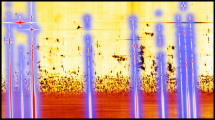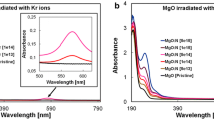Abstract
NaBr and KBr single crystals were exposed to X-ray (W-target, 30 kV, 20 mA) at room temperature and strain rate cycling tests associated with ultrasonic oscillation were carried out for the crystals at 77–293 K. The stress decrement (Δτ) due to oscillation and the stress change due to strain rate cycling have been measured during plastic deformation. The relative curve of ∆τ and strain rate sensitivity (λ) of flow stress has a stair-like shape for the two kinds of crystals. That is to say, the curve has two bending points and is divided into three regions: two plateau regions and the region between the two bending points, where λ decreases gradually with increasing ∆τ. The first region is a plateau within the small ∆τ. This implies that X-ray-induced defects have weak interaction with dislocation and act as obstacles to dislocation motion. Furthermore, the dependence of stress decrement (τ p) at the first bending point on the activation volume (V) obtained from the difference between λ in the first and second plateau regions reflects the interaction between dislocation and defects induced by the X-irradiation. The activation energy for the break-away of a dislocation from the defect could be obtained on the basis of τ p–V curve fitting the Barnett model to the experimental results. Then, the values of activation energy are 0.76 and 0.81 eV for NaBr and for KBr, respectively.










Similar content being viewed by others
References
Meshii M (1968) Interaction of glide dislocations with interstitials and lattice vacancies. In: Proceedings of symposium on the interactions between dislocations and point defects, Harwell, pp 566–603
Sibley WA, Sonder E (1963) Hardening of KCl by electron and gamma irradiation. J Appl Phys 34:2366–2370
Nadeau JS (1964) Radiation hardening in alkali-halide crystals. J Appl Phys 35:1248–1255
Reppich B (1971) Radiation hardening of alkali halides and magnesium oxide. Scr Metall 5:289–293
Tanimura K, Fujiwara M, Okada T, Hagihara T (1978) Mechanism of low-temperature radiation hardening in alkali halides I Single halogen interstitials as the hardening agent at low temperature. J Appl Phys 49:5452–5456
Tabachnikova ED, Podolskiy AV, Smirnov SN, Psaruk IA, Liao PK (2014) Temperature dependent mechanical properties and thermal activation plasticity of nanocrystalline and coarse grained Ni-18.75 at.% Fe alloy. IOP Conf Ser: Mater Sci Eng 63:012105
Okazaki K (1996) Solid-solution hardening and softening in binary iron alloys. J Mater Sci 31:1087–1099. doi:10.1007/BF00352911
Messerschmidt U (2010) Dislocation dynamics during plastic deformation. Springer, Berlin
Kataoka T, Ohji H, Kishida K, Azuma K, Yamada T (1990) Direct observation of glide dislocations in a KCl crystal by the light scattering method. Appl Phys Lett 56:1317–1319
Kosugi T (2001) Temperature dependence of amplitude-dependent internal friction due to simultaneous breakaway of a dislocation from several pinning points. Mater Sci Eng A 309–310:203–206
Gremaud G (2001) Dislocation-point defect interactions. Mater Sci Forum 366–368:178–246
Urusovskaya AA, Petchenko AM, Mozgovoi VI (1991) The influence of strain rate on stress relaxation. Phys Status Solidi A 125:155–160
Dotsenko VI (1979) Stress relaxation in crystals. Phys Status Solidi B 93:11–43
Johnston WG, Gilman JJ (1959) Dislocation velocities, dislocation densities, and plastic flow in lithium fluoride crystals. J Appl Phys 30:129–143
Granato AV, Lücke K (1956) Theory of mechanical damping due to dislocations. J Appl Phys 27:583–593
Ohgaku T, Matsunaga T (2009) Interaction between dislocation and divalent impurity in KBr single crystals. IOP Conf Ser: Mater Sci Eng 3:012021
Kohzuki Y (2009) Study on the interaction between a dislocation and impurities in KCl: Sr2+ single crystals by the Blaha effect—part IV influence of heat treatment on dislocation density. J Mater Sci 44:379–384. doi:10.1007/s10853-008-3150-8
Kohzuki Y (2010) Bending angle of dislocation pinned by an obstacle and the Friedel relation. Philos Mag 90:2273–2287
Seitz F (1946) Color centers in alkali halide crystals. Rev Mod Phys 18:384–408
Seitz F (1954) Color centers in alkali halide crystals II. Rev Mod Phys 26:7–93
Klein MV, Kennedy SO, Gie TI, Wedding B (1968) The hydroxyl ion in alkali halide crystals-crystal growth and characterization. Mater Res Bull 3:677–686
Markham JJ (1966) F-centers in alkali halides. Solid state physics, supplement 8. Academic Press, New York
Sirdeshmukh DB, Sirdeshmukh L, Subhadra KG (2001) Alkali halides. Springer, Berlin
Conrad H (1964) Thermally activated deformation of metals. J Met 16:582–588
Kohzuki Y, Ohgaku T, Takeuchi N (1995) Interaction between a dislocation and various divalent impurities in KCl single crystals. J Mater Sci 30:101–104. doi:10.1007/BF00352137
Nadeau JS (1962) Color centers and the flow stress of LiF single crystals. J Appl Phys 33:3480–3486
Sirdeshmukh DB, Sirdeshmukh L, Subhadra KG (2006) Micro- and macro-properties of solids. Springer, Berlinn
Zakrevskii VA, Shul’diner AV (2000) Dislocation interaction with radiation defects in alkali-halide crystals. Phys Sol Stat 42:270–273
Barnett DM, Nix WD (1973) The interaction force between tetragonal defects and screw dislocations in cubic crystals. Acta Metall 21:1157–1168
Mitchell TE, Heuer AH (1977) Solution hardening by aliovalent cations in ionic crystals. Mater Sci Eng 28:81–97
Friedel J (1964) Dislocations. Pergamon Press, Oxford, pp 223–226
Acknowledgements
We would like to thank S. Matsumoto and H. Takeno for their experimental assistance.
Author information
Authors and Affiliations
Corresponding author
Ethics declarations
Conflict of interest
The authors declare that they have no conflict of interest.
Rights and permissions
About this article
Cite this article
Kohzuki, Y., Ohgaku, T. X-ray-induced defects as obstacles to dislocation motion in alkali halide crystals. J Mater Sci 52, 3959–3966 (2017). https://doi.org/10.1007/s10853-016-0657-2
Received:
Accepted:
Published:
Issue Date:
DOI: https://doi.org/10.1007/s10853-016-0657-2




